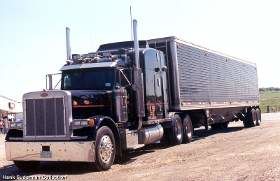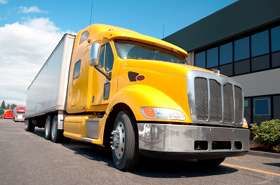Weight Change On Steers When Sliding Trailer
Topic 14284 | Page 1
It also depends on the trailer manufacturer and the distance between the holes. The weight shift can range from 250 - 500 on the drives. Honestly (I might be wrong saying this and I'm sure someone will correct me if so) the weight on the steer axle very rarely comes into play when scaling out and balancing a trailer. Yes it is a concern but more times than not, the issue is with the drives and trailer tandems.
Tandems:
Tandem Axles
A set of axles spaced close together, legally defined as more than 40 and less than 96 inches apart by the USDOT. Drivers tend to refer to the tandem axles on their trailer as just "tandems". You might hear a driver say, "I'm 400 pounds overweight on my tandems", referring to his trailer tandems, not his tractor tandems. Tractor tandems are generally just referred to as "drives" which is short for "drive axles".
Tandem:
Tandem Axles
A set of axles spaced close together, legally defined as more than 40 and less than 96 inches apart by the USDOT. Drivers tend to refer to the tandem axles on their trailer as just "tandems". You might hear a driver say, "I'm 400 pounds overweight on my tandems", referring to his trailer tandems, not his tractor tandems. Tractor tandems are generally just referred to as "drives" which is short for "drive axles".
Michael, sliding the tandems on your trailer should not affect your steers, but rather your drive axles. If one wants to change the weight on their steers this is accomplished by sliding the fifth wheel.
Tandems:
Tandem Axles
A set of axles spaced close together, legally defined as more than 40 and less than 96 inches apart by the USDOT. Drivers tend to refer to the tandem axles on their trailer as just "tandems". You might hear a driver say, "I'm 400 pounds overweight on my tandems", referring to his trailer tandems, not his tractor tandems. Tractor tandems are generally just referred to as "drives" which is short for "drive axles".
Tandem:
Tandem Axles
A set of axles spaced close together, legally defined as more than 40 and less than 96 inches apart by the USDOT. Drivers tend to refer to the tandem axles on their trailer as just "tandems". You might hear a driver say, "I'm 400 pounds overweight on my tandems", referring to his trailer tandems, not his tractor tandems. Tractor tandems are generally just referred to as "drives" which is short for "drive axles".

Michael, sliding the tandems on your trailer should not affect your steers, but rather your drive axles. If one wants to change the weight on their steers this is accomplished by sliding the fifth wheel.
I know the effect is smaller, but there is an effect. I have had to correct an overweight problem on my steers before by slidingredients tandems.
nobody answered my question.
Tandems:
Tandem Axles
A set of axles spaced close together, legally defined as more than 40 and less than 96 inches apart by the USDOT. Drivers tend to refer to the tandem axles on their trailer as just "tandems". You might hear a driver say, "I'm 400 pounds overweight on my tandems", referring to his trailer tandems, not his tractor tandems. Tractor tandems are generally just referred to as "drives" which is short for "drive axles".
Tandem:
Tandem Axles
A set of axles spaced close together, legally defined as more than 40 and less than 96 inches apart by the USDOT. Drivers tend to refer to the tandem axles on their trailer as just "tandems". You might hear a driver say, "I'm 400 pounds overweight on my tandems", referring to his trailer tandems, not his tractor tandems. Tractor tandems are generally just referred to as "drives" which is short for "drive axles".
nobody answered my question.
Actually we did, but you don't seem to want to accept it. I have never been able to change the weight on my steers by sliding my tandems. Maybe it changes slightly, but nothing that would need to be written into an excel spread sheet because it is an insignificant change. I would be interested in hearing how you corrected an overweight problem on your steers by sliding your tandems.
Tandems:
Tandem Axles
A set of axles spaced close together, legally defined as more than 40 and less than 96 inches apart by the USDOT. Drivers tend to refer to the tandem axles on their trailer as just "tandems". You might hear a driver say, "I'm 400 pounds overweight on my tandems", referring to his trailer tandems, not his tractor tandems. Tractor tandems are generally just referred to as "drives" which is short for "drive axles".
Tandem:
Tandem Axles
A set of axles spaced close together, legally defined as more than 40 and less than 96 inches apart by the USDOT. Drivers tend to refer to the tandem axles on their trailer as just "tandems". You might hear a driver say, "I'm 400 pounds overweight on my tandems", referring to his trailer tandems, not his tractor tandems. Tractor tandems are generally just referred to as "drives" which is short for "drive axles".

As old school has already said, not enough of a change to worry about. From sliding my trailer tandoms from all the way back to the 40 foot mark only changes my weight on my stears from 80 to 120 pounds depending on trailer. Sliding my 5th wheel changes about 500 pounds per pin on or off my stears. If your over weight enough on your stears to cause a problem, you need to have less fuel onboard or move your 5th wheel back.
Michael, there is some really great information in our weights and balance section of the High Road Training program that you might find helpful.
CDL:
Commercial Driver's License (CDL)
A CDL is required to drive any of the following vehicles:
- Any combination of vehicles with a gross combined weight rating (GCWR) of 26,001 or more pounds, providing the gross vehicle weight rating (GVWR) of the vehicle being towed is in excess of 10,000 pounds.
- Any single vehicle with a GVWR of 26,001 or more pounds, or any such vehicle towing another not in excess of 10,000 pounds.
- Any vehicle, regardless of size, designed to transport 16 or more persons, including the driver.
- Any vehicle required by federal regulations to be placarded while transporting hazardous materials.

The other thing that effects the weight transferred to the steer axle is actually the 5th wheel position. On some trucks if the plate is all the way to the back you can actually remove weight from the steer because the kingpin is behind the pivot point of the rear axle tandem setup.
There are too many variables to give a quick and easy cut and dry answer. The best answer someone could give is "It depends....."
Tandem:
Tandem Axles
A set of axles spaced close together, legally defined as more than 40 and less than 96 inches apart by the USDOT. Drivers tend to refer to the tandem axles on their trailer as just "tandems". You might hear a driver say, "I'm 400 pounds overweight on my tandems", referring to his trailer tandems, not his tractor tandems. Tractor tandems are generally just referred to as "drives" which is short for "drive axles".
Every time you weigh-slide tandems-reweigh, enter the number of holes you slid and the change in weight on the steers in a spreadsheet row, then when you have enough rows, use the linear regression function to see if there is a linear relationship.
BTW Michael, I agree that there does seem to be at least a small change, and I see where you said in your first post "I know the change will be small". I think I'm a fellow geek who understands why you want to do this even if it's a small change. It would be cool to be able to model the truck so you could write a program to enter the axle weights and have it tell you the best tandem/5th wheel settings to use. But I also know in reality it would be overkill. I only started out 3 months ago and I can usually get close just by looking at how far back the trailer is loaded.
Tandems:
Tandem Axles
A set of axles spaced close together, legally defined as more than 40 and less than 96 inches apart by the USDOT. Drivers tend to refer to the tandem axles on their trailer as just "tandems". You might hear a driver say, "I'm 400 pounds overweight on my tandems", referring to his trailer tandems, not his tractor tandems. Tractor tandems are generally just referred to as "drives" which is short for "drive axles".
Tandem:
Tandem Axles
A set of axles spaced close together, legally defined as more than 40 and less than 96 inches apart by the USDOT. Drivers tend to refer to the tandem axles on their trailer as just "tandems". You might hear a driver say, "I'm 400 pounds overweight on my tandems", referring to his trailer tandems, not his tractor tandems. Tractor tandems are generally just referred to as "drives" which is short for "drive axles".
It would be cool to be able to model the truck so you could write a program to enter the axle weights and have it tell you the best tandem/5th wheel settings to use. But I also know in reality it would be overkill
That is very true.
The 5th wheel will have a sweet spot where it belongs. When you're loaded heavy, very close to 80,000 pounds, with about a half tank of fuel, get the balance right between your drive axles and your trailer tandems. They should both be around 33,700 or so depending on your exact weight. With your trailer tandems and drive axles well balanced and your gross near 80,000 your steer axle should be right at about 12,000, possibly one or two hundred pounds over. If it's not then slide your 5th wheel so that it is. Then never touch it again. Once your 5th wheel is in the right spot you'll never need to move it. In fact you'll see a small percentage of the trucks on the road don't even have a sliding 5th wheel for that reason. It really isn't necessary if it's located in the proper position for that truck.
As far as sliding the tandems on the trailer to get your trailer tandems and drive axles balanced out, as was alluded to earlier the amount of weight transferred will depend upon the distance between the holes in the rail that the tandem pins go through. Most trailers nowadays move about 250 pounds each. So if you needed to move 1,000 pounds from your trailer tandems to your drives you would slide the trailer tandems back 4 holes.
It's really that simple. You won't need any sort of program to help you with it. Once you set that 5th wheel it's simply a matter of sliding the tandems a little here or there to get things balanced out and you'll know ahead of time how much weight will move with each hole.
Tandems:
Tandem Axles
A set of axles spaced close together, legally defined as more than 40 and less than 96 inches apart by the USDOT. Drivers tend to refer to the tandem axles on their trailer as just "tandems". You might hear a driver say, "I'm 400 pounds overweight on my tandems", referring to his trailer tandems, not his tractor tandems. Tractor tandems are generally just referred to as "drives" which is short for "drive axles".
Tandem:
Tandem Axles
A set of axles spaced close together, legally defined as more than 40 and less than 96 inches apart by the USDOT. Drivers tend to refer to the tandem axles on their trailer as just "tandems". You might hear a driver say, "I'm 400 pounds overweight on my tandems", referring to his trailer tandems, not his tractor tandems. Tractor tandems are generally just referred to as "drives" which is short for "drive axles".
New Reply:
New! Check out our help videos for a better understanding of our forum features

















Preview:








 TT On Facebook
TT On Facebook
I'm writing an excel program for the phone that calculates weight distribution and the amount of holes to slide trailer for equal load distribution and I'm needing to know roughly how much weight is placed on the steers (or removed) when trailer is slid one hole (assuming weight is perfectly distributed along length of trailer and each hole is accountable for 250 pounds on drives/trailer axil).
I know the variables effecting this are:
1. how trailer was loaded 2. type of trailer (gap size between holes) 3. type of freight
I'm looking for the mean average weight (or perhaps even median).
I know the change will be small.